For gold mining Russia in recent years shows a steady rise, entering the top five countries are major producers of this precious metal. About 700 gold mining companies in the country annually give about 170 tons of gold. About half of the gold is extracted from ores, and half of placers.
In Russia, a lot of non-industrial placers, which nobody does. Under nonindustrial scattering refers to scattering in which no stocks for industrial extraction, i.e. the extraction of gold using industrial equipment (excavators, bulldozers, dredges, etc.)
This is primarily placers, of which industrial reserves already extracted. However a lot of gold in them still. Often much gold remains in the sides quarries, because the existing legislation does not allow the enterprise beyond the pit. Gold remains in the tailings washed rocks. Except in Soviet times, in the course of exploration found in remote areas a lot young alluvial deposits, gold reserves (a few pounds) can't be considered industrial. For fans of interest and Kosovo placer, where scaly gold is deposited after each flood.
If you intend to search for gold, first of all you should decide the place where you will work. Where there is no gold, you won't find him. You should examine the relevant literature, to collect materials for old and new mines, figure out where they met the nuggets, where there were only small gold (the detector is not triggered).
Where there is the gold?
One of the sources of gold on the earth are quartz veins containing gold. These veins were formed hundreds of millions of years ago and since then it has been weathering under the influence of heat and cold, plants and animals, rain and wind, of snow and ice. The rich gold-bearing veins have collapsed, quartz breed of gold was washed away by the water in the river. Powerful streams of water during heavy rains create a continuous movement of stones, smashing and dousing them and sorting them the size, shape and density. Gold, being much heavier than many other material tends to be deposited in certain places by the movement stream. Such deposits are called alluvial.
Finding and developing such deposits requires an understanding of where to accumulate heavy materials when moving them with a stream of water.
Immediately in the vein gold has a crystalline form. Once in the river, it often separated from the quartz and acquires a rounded shape. Experienced geologists on degree of roundness of the nugget can fairly accurately say how long it traveled over the river and where it can be the main vein.
There are several types of gold deposits resulting from the weathering lived.
1. Residual otlozheniime. This pieces of veins, which were formed as a result chemical and physical weathering of gold-bearing veins and are close proximity to it.
2. Eluvial deposits. Consist of these pieces and separate the nuggets, which under the action of forces of nature moved from the veins, but not in smiggy the river. Fragments of destruction veins are often located on the hillside below the initial core.
3. Terraced deposits. Reaching the river, the gold is deposited on the bottom. River with time cuts through the ground deeper. As a result the old river bed is high above the water level. This so-called terraces. Often terraces lie low above the water level. However, some terraces are far from modern river. Sometimes it's the remains of ancient rivers that flowed millions of years ago before the formation of the modern river system. Sometimes these terraces be on the tops of mountains, in deserts, etc. As a rule, ancient terraces high gold content.
Most surface mining operations connected with today the development of terraced deposits. The reason for this is that the presence of old bottom sediments is evidence that their no one has yet developed. Any gold that is deposited, is still in place.
4. Bottom sediments. In order to discuss what happens to gold when it falls into the water flow, you first need to learn the two concepts of the raft and fat. Many millions of years ago, when the earth cooled down, the outer surface froze into solid rock. The subsequent layers of sand, gravel, rocks are called sediments or sedimentary rocks. In some places the thickness of sedimentary rocks is hundreds of meters. In other places, especially in the mountains and on the shores of the seas, indigenous volcanic rock often completely naked.
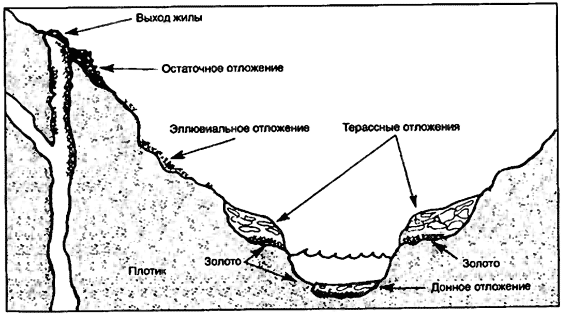
Fig. 45. The movement of gold from the weathered veins into the river
The river bed is composed of rocks, sand, gravel, clay (sedimentary rocks) everywhere lie on bedrock (the raft).
Heavy rains in mountainous areas usually cause very strong streams of water, which wash away sediments to bedrock. This leads to gradual the erosion of the bottom and the deepening of the riverbed for a long time. Except the water flows from the mountains wash away all the new pieces of gold into the river, where it mixed with other materials. The gold, being heavier than these materials, in the process of moving gravel and sand along the river out quickly down to the bottom, where it is retained by the unevenness of the bedrock.
Since the gold 6-7 times heavier than other materials surrounding it, requires much more effort to move it down the river, compared with the stone material. Therefore, even with heavy rain, when the water in the river rises and with more force begins to erode sediment at the bottom and to carry the stones and pebbles, nuggets of gold lying on the raft, often remain fixed.
In that case, when the power flow is sufficient to move the gold, it can to be deposited in another place, where the force of the flow is weakened.
Trap of gold on the raft
The irregularities of the bottom play a big role in the accumulation of gold. Streams of water capable to move the gold, usually wash these irregularities from clay and sand, leaving only for gold.
Some types of rocks form a large number of irregularities, providing numerous traps for gold. Particularly effective cracks and ledges, perpendicular to the flow.
Obstacles in the flow path, such as a large stone, inhibit the flow and can to facilitate the deposition of gold in front of him or behind him.
One of the most common places in the river to find gold is where the raft forms a cliff of a deep pond. Any place where a fixed volume of water suddenly flows into a significantly large volume of water, or a place where the speed flow slows down, is a trap for gold, which can build up in these places in large numbers. So the waterfall can have a significant accumulation of gold, but not always. Sometimes the water creates a strong turbulence, any gold trapped in a hole under a waterfall during the flood, will be clean up. On the other hand, the hole may be large boulders that protect the gold from being washed out. In this case, you will be lucky.
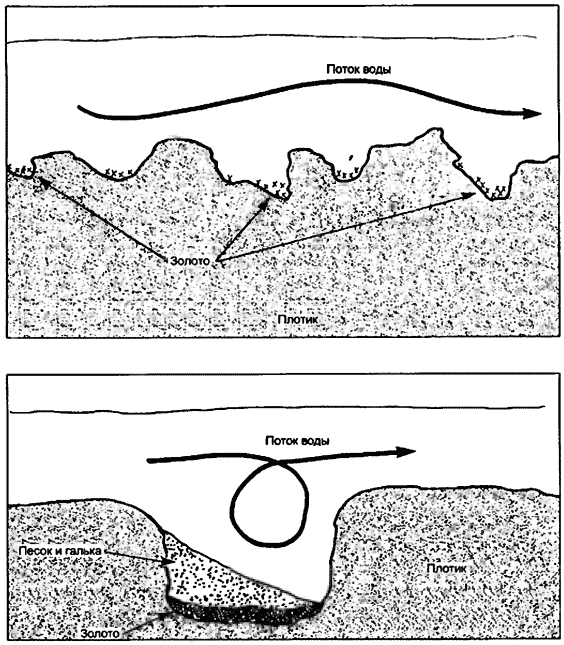
Fig. 46. The irregularities of the river bottom - traps floating gold
In some cases, the gold washed out of the hole under the waterfall, can settle immediately for the pit, where the flow hasn't yet got enough speed. Sometimes in hot weather streams shallow pit and under the waterfall contains little water, allowing you to scrape out the nuggets.
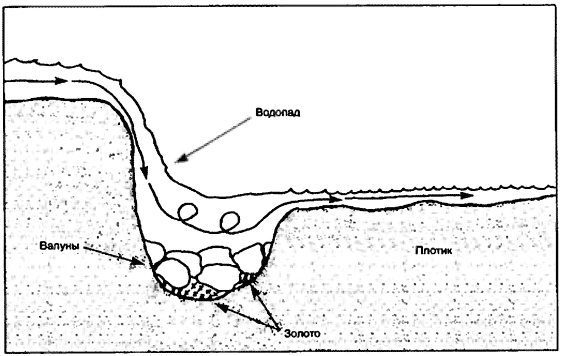
Fig. 47. Capture gold in a hole under a waterfall
Another common place where you can Deposit gold, this is the place where the stream the current along the slope of the hill, suddenly out of the plain. Such places may also to contain large quantities of gold.

Fig. 48. The deposition of gold during transition of a mountain stream on the plain
The path of the movement of gold
Because of the gravity of the gold is moving along the river the path of least resistance. In most cases, the shortest distance between big river bends. Delayed spits on the inner bends of the river. If the way gold has large stones, some of them gold can accumulate. Under other stones it may not be.
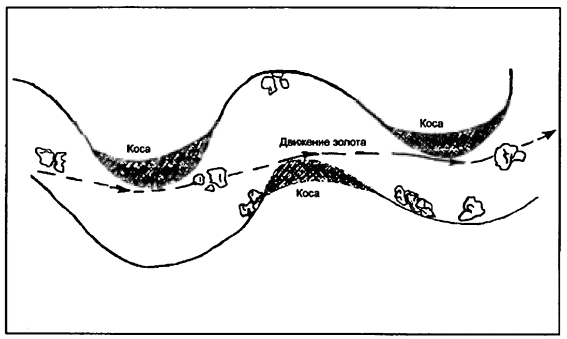
Fig. 49. The deposition of gold on the river spits
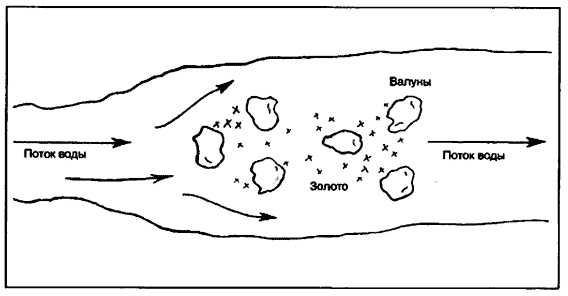
Fig. 50. The deposition of gold around large boulders
When a river or stream suddenly expand, then there may also settle the gold, as the water velocity decreases sharply. In this place often for the same reason and large stones.
Ancient river
About 2 million years ago, the river system was very different from modern. The ancient river had washed away the gold ore and accumulated rich fat. But the topography of the earth changed. Channel some rivers were on the tops mountains, others in the modern wilderness. Just some river remained close to modern drainage system.
Most of the gold in modern rivers is gold from the sediments of ancient channels through which now flow in the river.
Deposits of ancient rivers contain a lot of gold. And where the modern river cross these deposits, also contains a lot of gold.
Ancient terraces, generally contain very rich gold bottom layer. This layer usually has a dark blue color is a characteristic feature of the ancient riverbed. Ancient blue pebbles usually are oxidized and turn into a rusty - red after digging and lying on the air. Often the ancient gravel terraces and very solid dense.
Most of the high terraces are remnants of the modern rivers. They were formed from 1 500 000 to 10 000 years ago. They are usually developed with the help jetting. For the development of sediment applied Draghi. In both cases is captured only 30-40% of gold. The rest of the gold together with empty the breed is lost, going in the dumps where it is available for artisanal mining using metal detectors
Equipment to search for nuggets
Abroad prospecting and mining for gold using metal detectors and minerally fashionable pastime since the late 70s, when the price of gold rose to $ 800 for ounce.
Unfortunately, conventional metal detectors detect gold. Therefore, all the leading companies have developed specialized detectors for search gold. These nuggets can be detected up to a depth of 1 m, and small (about the size of a bullet) - at a depth of 8 - 15 cm. Such devices may also to build up from a small gland, which in a lot of meets on the territory of the mines, and from the black magnetite sand, which is characteristic for gold deposits.

Fig. 51. Search nuggets using a metal detector (website www.kladoiskatel.ru)
To search for nuggets recommended for use with the following detectors:
1. Gold Master and GMT (firm White's).
2. Lobo Super Track (firm Tesoro).
3. Gold Bug 2 (Fisher),
4. Stinger (firm Garrett).
If the ground is heavily minerals and these devices do not allow to make it efficient operation, it is recommended to use devices from Minelab SD 2000, SD 2200, GP 3500, GPX 4000. These devices are more expensive and heavy, depth detection is the same as in the above devices, however, their main
the advantage is that they almost do not react to the ground. Though the metal detector is fairly simple to use, required some practice in work with him to learn how to effectively use it to find gold.
Application features of the metal detector when searching for nuggets
Search nuggets differs from searching for coins. Large nugget device finds without difficulty, but unfortunately, most of the nuggets have small size, often less than a match head They only cause a slight change in the threshold of the background that you have to catch. Despite the abundance of metal debris in the mines, searching should be conducted in All metals", i.e. without discrimination. This is because the conductivity iron and native gold are almost the same, and, after it was rebuilt from the iron you lose the gold.
Secondly, it is necessary to work on headphones. Only through them you can to detect small nuggets and deep, especially where the soil is mineralized and creates a disturbing noise.
Sensitivity should not be too high otherwise the ground is a lot of false signals, to check where you are wasting time. Less sensitivity gives a deeper penetration depth in mineralized the ground.
One of the most important factors when searching for nuggets is to install proper ground balance and maintaining it in the process.
Without a proper ground balance you will not find a nugget. Configure the device on the middle ground. When properly configured threshold you hear a quiet sound background. This must be done before setting up the "ground balance". Then, if you hold the coil to ground, threshold may increase or decrease. It suggests that it is necessary to adjust the ground balance using appropriate handles.
At the mines, as a rule, the salinity of the pound changes frequently and the device must re-adjusted every 5 to 6 m. If, when you move the noise intensified, the soil has become less mineralized. If the noise died down, the mineralization increased. With time you will learn how to determine when it is necessary to adjust ground balance".
Sometimes the best result is if you adjust the ground balance with the positive bias region. This gives increased sensitivity to small the nuggets when searching on sites with little mineralization. In practice, this means louder threshold at the approach of the coil to the ground. Just handle the regulation of this threshold is not achieved. You need to spin the handle "Balance soil".
Steeply the mineral soil, try to set "balance ground" to the negative range. It will reduce the sensitivity to small nuggets, but gives you the opportunity to find nuggets that you wouldn't otherwise have found.

Fig. 52. Stone brush in the river bed - the perfect trap gold (website www.kladoiskatel.ru)
It is helpful to have a little nugget (size 4-5 mm) and use when setting up the product. If nugget you have not, you can successfully to use for this purpose a piece of lead.
During the work keep the coil as close to the ground. Having received the signal, scan the object in different directions. If the signal is heard only when a certain direction of movement of the coil, it is definitely not a natural. If when raising the coil over the ground signal abruptly disappears, it's not nugget and not metal. The signal from the metal fades gradually when lifting the coil.
Pay special attention to very weak signals, as they often indicate the presence of a nugget.
The coil must be moved at low speed, and much less than coins.
Hot stones
In addition to the metal debris, searching for nuggets, so greatly annoy called hot rocks Is the rock fragments, the salinity of which is much different from the average mineralization, which is configured on your device. So they give an audible signal similar to the signal from the nugget. Hot stones can be different size and color. The signal from these stones quickly fades when lifting coil unlike the signal from the metal. In addition, the signal from the metal more clearly, while the hot stones give a more "spread out" signal when you spend a coil over it. Often the stones give a signal when you move the coil only in one direction, while the signal from the nugget audible at any movement above him on the coil.
Finally, by lowering the sensitivity of the device can be achieved that the signal from stone will disappear, whereas the signal from the nugget still be heard, though weakened.
Thus, with practice you will learn to identify the majority of hot stones and don't waste time digging them
The search place of work jetting
When you search gold metal detector, perhaps the most productive places the places where gold was once mined, eroding the rock giant. Often the rock is washed away to the raft. This allows us to investigate with the help of the device all the cracks and other traps of gold, which often yields remarkable results.
During these searches, pay attention to the color of mud, which is typical for areas with gold. Often it has a certain color, and then you can to find such places only by the color of the soil and then test them the metal detector.
Search in the dumps
Gold mining by using dredges to extract gold, there had only been a relatively small breed and large pieces the size of a fist and walked over to blade. Along with them to the dump often went to large nuggets. Those nuggets what was on the surface, has already been found, but in the dumps can be found using the metal detector still nuggets to a depth of 50 cm If possible dumps you to cut a bulldozer. checking the soil with a metal detector after each pass.
Wash trays
Regardless of whether you are going to find gold with a metal detector or to retrieve it using minidrag, the tray still remains one of the most useful tools used today by search engines. The tray is necessary in primarily for sampling for gold in various places, until you stumble on the site, where you will be able to work efficiently with your equipment. Except for the layperson tray is the main tool for collecting gold along with a metal detector.
There are many different types of trays. Generally for leaching of gold can use a small basin or pan. But give the best results special plastic or metal trays with solotorovsky grooves. The trays can be round or rectangular. Iron pans have a number of disadvantages. First, they must from time to time to anneal to remove grease from hands. Secondly, they strongly corrode. They are magnetic and are therefore difficult to separate the magnetite from the gold using magnet. In such a tray, it is impossible to verify the presence of a nugget detector. But they can cook food.

Fig. 53. Washing of gold-bearing rocks of the tray (website www.kladoiskatel.ru)
Plastic trays are lightweight, non-magnetic, corrosion - resistant, do not respond to the metal detector. Green plastic makes it easier to see sparkles of gold. The grease from your hands can easily be removed with a cotton swab dipped in alcohol or gasoline.
Dimensions of large tray - from 15 cm to 40 cm Pan diameter 40 cm fully loaded weighs about 10 lbs. So it's best to use a pan with a diameter of 35 see It allows you to work faster. To work with the tray, it is desirable to apply and plastic sieve with cell size of 12 mm.
Russia has long used wooden trays of rectangular shape, made from deified inside larch. Formed during the roasting grooves successfully trap fine gold.
For professional gold mining pans are not used, because during the day you can to process a small amount of material, but for an Amateur production and for sampling the most rich gold places the tray is very a helpful tool. Generally, a quick washing of sand in the trays is art which, over time, everyone can master.
The trays allow you to work without water, although this requires a lot of practice. This is especially useful when working on old river channels or in the desert, where there is no water. As a rule, using the tray for a week's work, you can pan from 30 g to 80 g of gold. But some are lucky more.
Minitage
Minitage is a device which works on the principle of a vacuum cleaner, allowing sucking from the bottom of the river sand and pebbles together with gold, if it's there present, and separating the gold from the waste rock
Minitage vary in size and design, however they all contain 5 main components - a system that ensures the buoyancy of the installation, the engine, rendering the action of the centrifugal pump, the injector, the flushing gutter, ensuring the separation of gold from waste rock , air supply system for breathing under water. For small minidrag that operate on shallow streams, the latter is not required.
The principle of operation is shown in Fig. 54. Water under high pressure on the hose And enters the injector. This creates a Venturi effect, whereby that water is sucked through the nozzle of the injector, while grabbing from the bottom of the sand and pebbles, and is fed to the grid of the wash trough. The smallest of minidrag has a weight of 24 kg. the Pump is driven two-stroke engine in 2 HP suction hose Diameter - 50 mm. Capacity - 100 kg of material per hour.
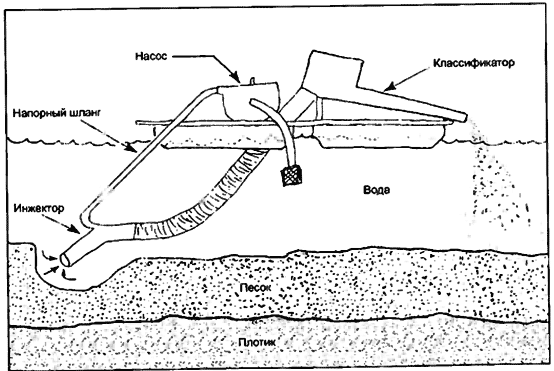
Fig. 54. The principle of operation of minitage
Larger minitage weighs about 90 kg. hose Diameter - 100 mm ideal conditions can handle about 1000 kg of material per hour. In reality, such ideal conditions are very rare. In practice one has to move large stones, loosen the bottom sediments, etc.
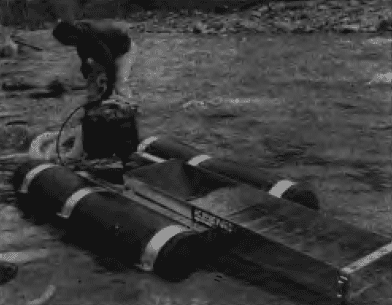
Fig. 55 Minitage
Abroad (Canada, USA, Brazil, New Guinea) such minitage won the great popularity and have been successfully applied to gold mining at shallow reservoirs.
Tester gold
This is another type of electronic device to find gold than the metal detector. It is a probe, one end of which there is a a touch device, feeling the presence of gold in the soil, and on the other end the pen and the electronic unit with the controls. When the probe stuck in the ground, and his the sensor comes into contact with gold particles, the speaker device emits specific beep and the light turns on. In the presence in the soil magnetite audible tone changes and the light changes color.
Unlike conventional metal detectors, the sensor of this device must have direct contact with the gold particle to have a positive signal, indicating the presence of gold Particles of gold may be very small, which usual a metal detector is not trapped.
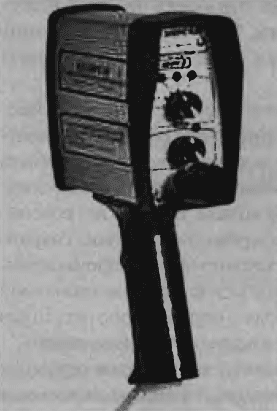
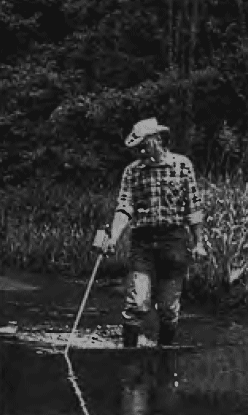
Fig. 56. Probe gold. Fig. 57. Searching for gold using a probe
The device is adjusted so that it gives the characteristic signals for gold, platinum, mercury and magnetite sand.
In some cases, the device is very useful, in others it can't be used (dense soil, rocks). Allows, however, to find areas with signs of gold. Can be lowered into the water. The kit includes an additional extension length of 120 see
The main problems with Amateur gold mining in Russia
Despite the huge amount of non-industrial placers, legal production of them gold lovers currently impossible. The reason is that Russian legislation, the development of non-industrial placers is not provided. Here is what says about this candidate of GEOL.-mineral Sciences "Irgiredmet" B. K. Kavcic:
"Obviously nonindustrial a scattering cannot be tendered to therefore, it is impossible to obtain a license, and if not approved stocks, gold mining may not be legal, so as to extract only explored and approved reserves. In General, all Russian legislation from licensing rules to the safety of gold is focused solely on industrial field. And since in non-industrial industrial placers stocks are by definition not, the whole chain of Russian laws is not applicable".
Because of the existing legislative "hole" a huge number of non-industrial placers are currently not being developed. Remnants of gold sometimes buried with the purpose of land reclamation, Kosov gold brought into the sea. The separate development of non-industrial placers are secretly in circumvention of the law...
Currently the Union of gold miners of the Russian Federation raised the issue of processing legislation on precious metals, and provides specific recommendations for legislation change. It is proposed to provide for the issuance of licenses for gold production from non-industrial placers, allowing to combine the enriched search nests of gold with them working legally.
Author: L. V. Bulgak






